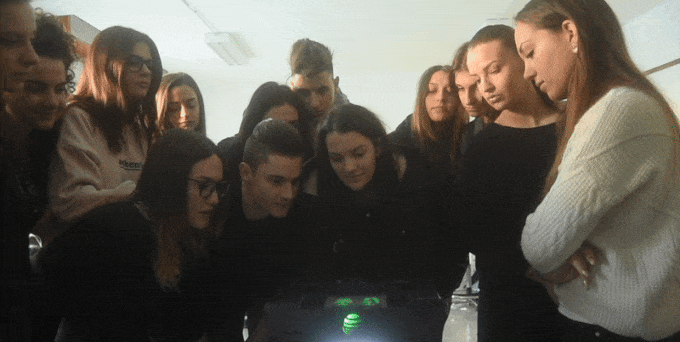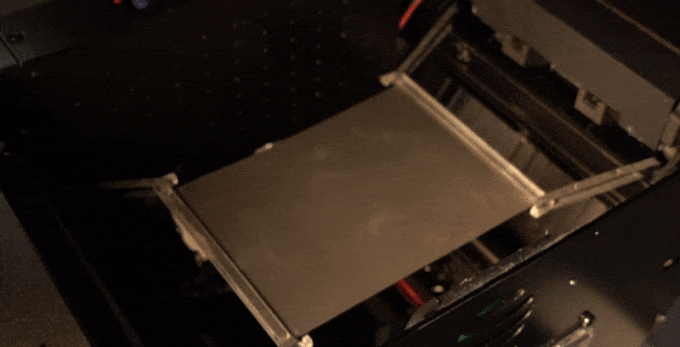Your 3D content on a real PoV volumetric display, no glasses needed!
VVD (Volumetric Visualization Device) is a patent pending solution invented by Lumi Industries, that allows a real three-dimensional visualization of 3D surfaces.
A PoV volumetric display device is a graphic display device that forms a visual representation of an object in three physical dimensions, as opposed to the planar image of traditional screens that simulate depth through a number of different visual effects.
"This is a real tridimensional representation. We have all these people who can watch it at the same time. You don't need to wear glasses on your face or virtual reality headset or something. It looks 3D and you can move around it. This is so cool!"
Caleb Kraft, Make Magazine Senior Editor
"We were able to view a prototype of the system recently, which is able to show a true, 3D representation of a 3D model. When I say, “true”, I mean that you can walk around it and your view is the same as if it were a solid object..."
VVD applications
Medical
3D Visualization of anatomical/dental models
VVD creates a new disruptive way to look at 3D imaging generated by 3D scanners or magnetic resonance scanners and computed tomography (CT) scanners , which can now be explored from any point of view, without additional glasses, opening up to endless applications in the medical sector and bringing key benefits such as
Increasing patient awareness and education, with a much easier to understand visual explanation of the undergoing procedure;
Increasing efficiency and less unexpected issues in the operating room, since a surgeon can see a better 3D visualization of the involved body parts, allowing for a better understanding and preparation.
Medical experts can now study, discuss with their colleagues or explain to their students real case studies as 3D volumetric visualization that can be explored from any point of view, as if it was a real object in front of them.
Product Design & Engineering
Let's not waste time and money!
With VVD you can explore the design you have just created or double check all details of the mechanical component you have just developed, like if it was already in your hand, before going for prototyping. Because when you design in 3D, you are watching your work on a bi-dimensional screen. Perspective, created through visual effects, allows us to get an idea of the volume and proportions of what we are designing, but, believe us, to watch your model as it really is, is not the same thing!
Working on a real three-dimensional visualization from every angle, VVD can help you get a better general view of your assembly of components, checking that all of them are right, proportionate, their coupling is correct. You can even review it with your colleagues, because you are all watching at the same time, anyone from his personal point of view.
Since you can share the visualization experience with someone else, VVD becomes the perfect tool for any designer who need to discuss and revise a model with his client. Not to mention the “Whoa” effect the use of VVD can generate in your audience while using it to present your work!
Education & Training
Stimulate your students' curiosity!
It is not easy to keep a whole class interested in a lesson. Sometimes it seems that students are just bored and they are not absorbing any of the information you are hardly trying to teach. A suggestion can be to talk less and involve students more. The more the class is interactive and the more technology is used, the more students will enjoy what they are learning, because technology is what students nowadays live and breathe every day and they love it!
VVD: Volumetric Visualization Device, becomes a great tool to support the teacher in different ways like:
explaining and developing students three-dimensional visual and sensory perception;
representing complex concept like mathematical or chemical formulas in their three dimensions;
display body parts, artifacts, animals or any 3D model that can relate to your lesson, instead of using mere pictures.
Students can move around and fully understand model proportions. More people can watch the same model at the same time, encouraging discussion and opinions exchange with the teacher or among the students.
Museums & Exhibitions
Enhance visitors' experience!
The museum of the future must become a center for the community, a meeting and conversation place, where the public is involved in a continuous dynamism.
Normal display cases and graphics are more and more supported by videos, interactive displays, VR experience. When in need to show artifacts or archaeological finds which are not present in the museum but are related to the ongoing exhibition, museums make a wide use of pictures, drawings, schematic images.
VVD is a new affordable tool to make an exhibition visit more absorbing and interactive, to grab the attention of the public on special pieces we want to highlight. The front screen allows you to add captions, images, video and more information about the 3D models you are displaying.
Architecture,
Surface and Terrain visualization
Museo del Palacio de Bellas Artes in Mexico City, 3D Model by Daniel Huerta on My Mini Factory
Volumetric visualization of Mars MGS MOLA elevation model (MEGDR)
VVD can be used for the tridimensional visualization of terrains or geographic surveys using DEM elevation files.
With VVD, you can now watch a perfectly scaled model of the construction you are developing, with correct perspective and proportions, instead of or before investing on the creation of a traditional architectural model.
The VVD in action, filmed at 1000fps
The Science behind VVD
VVD projects the various horizontal layers of a 3D model on a special film vibrating very fast. This vibration of the image, exploit the "persistence of vision", a characteristic of our retina or brain, to retain an image after it has been removed, enabling us to perceive a whole object. This is believed to be the same principle of cinema animation techniques, where the viewer interprets a fast sequence of still images as a continuous moving image. This why this device is also called PoV (Persistence of Vision) volumetric display.
Technical Details
Please notice that since the VVD is still a live project, product and product specifications are subject to change. We are still improving and refining it every day! The specifications, and all the GIFs and videos refer to the current prototype, that has been shown already at CES (Las Vegas), FormNext (Frankfurt), Maker Faire (Rome, IT).
.STL files are already supported. Grayscale depth images can also be converted with our software. More files support will be added.
More than 39 million Voxels (608*684*96)
Current system is based on X86 / Windows board platform. Raspberry / Linux system is also being evaluated.
7" LCD for visualization of the interface, as well as photos/video that add information to the volumetric image shown.
Stereo speakers for audio description
Current viewing area: 90 x 55 x 45 mm
Compact design: the VVD is a stand-alone device with overall size of just 36 x 20 x 24 cm. Anodized aluminium frame and body.
Typical 45W, Max 144W (24V, 6A external power supply)
USB connection; Wi-Fi and Bluetooth will be evaluated
LATEST DEVELOPMENTS
A new updated and improved version of VVD Volumetric Visualization Device, was presented at Formnext 2018
stronger light source
more stable projection with the use of an additional projector
real 3D visualization from every angle thanks to the new lighter design of the structure.
Why VVD instead of Virtual reality glasses?
It might be remarked that a 3D model explorable from any point of can be rendered with Virtual Reality too.
VR is a great technology which is now becoming more and more familiar to people, but again it is a visual effect, not real tridimensionality. One device, multiple viewers.
To experience VR, you need to wear a visor which makes your experience personal and subjective. The great revolution of VVD is that one single device provides a sharable three-dimensional experience without the need of special glasses. This means that more people can watch at the same time the same 3D model from any point of view, giving a new possibility to discuss what is projected together with other people, being them your colleagues, your client, your students, your patients. This create new opportunities not only in product design, but in a huge number of different fields.
Why VVD is better than "3D holographic illusion pyramids"?
The VVD is a real volumetric visualization device: it means that the 3D projection can be seen from every point of view, and even if you move slightly, what you see will change, as if you were looking at a real object! In comparison, the so called "Holographic pyramids" just project 4 views of a 3D model, as you can see in the video below:
This means that if you are looking at the "hologram", and you move around it, you will not see a different image, until you move 90°; at that point, you will see a completely different image. You just have 4 views, front, back, left, right. If you use a spherical/cylindrical 3D model, you will notice less this, this is a trick used to make those display look more realistic than what they actually are. Looking from the top, or below, will not make you see what's on the top/bottom of the 3d model, you will still see only one of those 4 images.
Don't get us wrong: the "holographic pyramids" are cool! We even designed one some years ago, and with minimal materials, you can create a very interesting illusion! But it is not a real, useful volumetric visualization.
VVD has been awarded the "Maker of Merit" honor at European Maker Faire Rome 2017 by Make Magazine


















